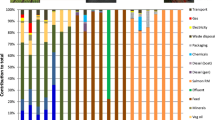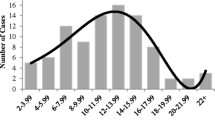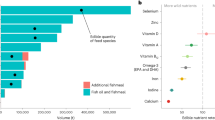Abstract
Purpose
Animal by-products may be increasingly relied upon to satisfy nutritional requirements of salmonids and other fed aquaculture species as demand for fish meal outpaces supply. Previous studies of aquaculture supply chains have included either no animal by-product inputs or small inputs of poultry by-products. Australian Atlantic salmon production includes high use of feed inputs derived from poultry and mammalian by-products and provides a case study to explore the environmental implications and methodological challenges associated with these inputs.
Methods
Life cycle assessment was carried out on a vertically integrated salmon production system in Tasmania, representing approximately 40% of Australian Atlantic salmon production. The system included feed production, smolt/juvenile production, farm grow-out, processing and packaging, and distribution of head-on gutted salmon to market. Impacts from animal production were allocated to by-products on a gross chemical energy basis. Scenario analyses were conducted to determine the extent to which changes in feed conversion ratio, feed composition, and other variables affect results. Sensitivity analysis was carried out on the allocation method for fishery and animal by-products.
Results and discussion
Environmental impacts associated with Tasmanian salmon fed high quantities of animal by-products were markedly higher than those of previously assessed systems. All impacts were driven by feed production with the exception of eutrophication potential, which was driven equally by feed production and nutrient loss during grow-out. Animal by-products accounted for the majority of all impacts from feed production. Adopting a feed composition without animal by-products would result in dramatic improvements, including a 70% decrease in greenhouse gas emissions. Allocation choice had a clear effect on results, with biophysical allocation methods placing much more burden from animal production on fed systems than economic or no-impact allocation methods.
Conclusions
The use of animal by-product inputs in aquaculture feeds has a substantial effect on the environmental profile of farmed salmon products. The magnitude of this effect is dependent on the allocation method chosen for the treatment of products and by-products in upstream systems. The high impact of such systems recognizes the environmental cost of future aquaculture production that may rely more on intensive and high-impact animal production inputs as more efficient fishery inputs become increasingly limited relative to demand.



Similar content being viewed by others
References
ASC (2012) ASC salmon standard version 1.0. Aquaculture Stewardship Council. http://www.asc-aqua.org/upload/ASC%20Salmon%20Standard_v1.0.pdf. Accessed 22 December 2015
Aubin J, Papatryphon E, van der Werf HMG, Chatzifotis S (2009) Assessment of the environmental impact of carnivorous finfish production systems using life cycle assessment. J Clean Prod 17:354–361
Ayer N, Martin S, Dwyer RL, Gace L, Laurin L (2016) Environmental performance of copper-alloy net-pens: life cycle assessment of Atlantic salmon grow-out in copper-alloy and nylon net-pens. Aquaculture 453:93–103
Ayer NW, Tyedmers PH (2009) Assessing alternative aquaculture technologies: life cycle assessment of salmonid culture systems in Canada. J Clean Prod 17:362–373
Ayer NW, Tyedmers PH, Pelletier NL, Sonesson U, Scholz A (2007) Co-product allocation in life cycle assessments of seafood production systems: review of problems and strategies. Int J Life Cycle Assess 12:480–487
Boissy J, Aubin J, Drissi A, van der Werf HMG, Bell GJ, Kaushik SJ (2011) Environmental impacts of plant-based salmonid diets at feed and farm scales. Aquaculture 321:61–70
BSI (2012) PAS 2050-2: 2012—Assessment of life cycle greenhouse gas emissions: supplementary requirements for the application of PAS 2050:2011 to seafood and other aquatic food products. British Standards Institution, London
Carter CG, Hauler RC (2000) Fish meal replacement by plant meals in extruded feeds for Atlantic salmon, Salmo salar L. Aquaculture 185:299–311
Cashion T, Tyedmers P, Parker RWR (2017) Global reduction fisheries and their products in the context of sustainable limits. Fish Fish. doi:10.1111/faf.12222
Chen X, Wilfart A, Puillet L, Aubin J (2017) A new method of biophysical allocation in LCA of livestock co-products: modeling metabolic energy requirements of body-tissue growth. In J Life Cycle Assess 22:883–895
D’Orbcastel ER, Blancheton J, Aubin J (2009) Towards environmentally sustainable aquaculture: comparison between two trout farming systems using life cycle assessment. Aquac Eng 40:113–119
Dekamin M, Veisi H, Safari E, Liaghati H, Khoshbakht K, Dekamin MG (2015) Life cycle assessment for rainbow trout (Oncorhynchus mykiss) production systems: a case study for Iran. J Clean Prod 91:43–55
Driscoll J, Boyd C, Tyedmers P (2015) Life cycle assessment of the Maine and southwest Nova Scotia lobster industries. Fish Res 172: 385-400
Durlinger B, Tyszler, Scholten J, Broekema R, Blonk H (2014) Agri-footprint; a life cycle inventory database covering food and feed production and processing. Proceedings of the 9th International Conference on Life Cycle Assessment in the Agri-food Sector, 8–10 October, 2014, San Francisco, USA
Ellingsen H, Olaussen JO, Utne IB (2009) Environmental analysis of the Norwegian fishery and aquaculture industry—a preliminary study focusing on farmed salmon. Mar Policy 33:479–488
El-sayed AM (1999) Alternative dietary protein sources for farmed tilapia, Oreochromis spp. Aquaculture 179:149–168
FAO (2016a) Environmental performance of animal feeds supply chains: guidelines for assessment. Food and Agriculture Organization of the United Nations, Rome
FAO (2016b) The state of world fisheries and aquaculture: contributing to food security and nutrition for all. Food and Agriculture Organization of the United Nations, Rome
FAO (2016c) Food outlook: biannual report on global food markets. Food and Agriculture Organization of the United Nations, Rome
Fréon P, Avadí A, Soto W, Negrón R (2014) Environmentally extended comparison table of large- versus small- and medium-scale fisheries: the case of the Peruvian anchoveta fleet. Can J Fish Aquat 71: 1459- 1474
Geisler G, Hellweg S, Hungerbühler K (2005) Uncertainty analysis in life cycle assessment (LCA): Case study on plant-protection products and implications for decision making. Int J Life Cycle Assess 10: 184-192
Goedkeep M, Heijungs R, Huijbregts M, Dr Schryver A, Stuijs J, van Zelm R (2009) ReCiPe 2008: A life cycle impact assessment method which comprises harmonized category indicators at the midpoint and the endpoint level. Ministry of Housing, Spatial Planning and Environment, Netherlands
Grönroos J, Seppälä J, Silvenius F, Mäkinen T (2006) Life cycle assessment of Finnish cultivated rainbow trout. Boreal Environ Res 11:401–414
Guinée J (2001) Handbook on life cycle assessment—operational guide to the ISO standards. Int J Life Cycle Assess 6: 255.
Hardy R (1996) Alternate protein sources for salmon and trout diets. Anim Feed Sci Tech 59:71–80
Henriksson P, Guinée J, Heijungs R, de Koning A, Green D (2014) A protocol for horizontal averaging of unit process data—including estimates for uncertainty. Int J Life Cycle Assess 19:429–436
Henriksson P, Guinée J, Kleijn R, de Snoo G (2012) Life cycle assessment of aquaculture systems—a review of methodologies. Int J Life Cycle Assess 17:304–313
ISO (2006) ISO 14044: environmental management—life cycle assessment—requirements and guidelines. International Organization for Standardization, Geneva
McGrath KP, Pelletier NL, Tyedmers PH (2015) Life cycle assessment of a novel closed-containment salmon aquaculture technology. Environ Sci Technol 49:5628–5636
Millamena OM (2002) Replacement of fish meal by animal by-product meals in a practical diet for grow-out culture of grouper Epinephelus coioides. Aquaculture 204:75–84
Naylor RL, Hardy RW, Bureau DP, Chiu A, Elliott M, Farrell AP, Forster I, Gatlin DM, Goldburg RJ, Hua K, Nichols PD (2009) Feed aquaculture in an era of finite resources. P Natl Acad Sci USA 106:15103–15110
Papatryphon E, Petit J, Kaushik SJ, van der Werf HMG (2004) Environmental impact assessment of salmonid feeds using life cycle assessment (LCA). Ambio 33:316–323
Parker, RWR (2011) Measuring and characterizing the ecological footprint and life cycle environmental costs of Antarctic krill (Euphausia superba) products. Masters thesis, Dalhousie University, Halifax, Canada
Parker RWR, Tyedmers PH (2012) Life cycle environmental impacts of three products derived from wild-caught Antarctic krill (Euphausia superba). Env Sci Technol 46:4958–4965
Parker RWR, Tyedmers PH (2015) Fuel consumption of global fishing fleets: current understanding and knowledge gaps. Fish Fish 16:684–696
Pelletier N, Ayer N, Tyedmers P, Kruse S, Flysjo A, Robillard G, Zieglers F, Scholz A, Sonesson U (2007) Impact categories for life cycle assessment research of seafood production systems: review and prospectus. Int J Life Cycle Assess 12:414–421
Pelletier N, Tyedmers P (2007) Feeding farmed salmon: is organic better? Aquaculture 272:399–416
Pelletier N, Tyedmers P (2011) An ecological economic critique of the use of market information in life cycle assessment research. J Ind Ecol 15:342–354
Pelletier N, Tyedmers P, Sonesson U, Scholz A, Ziegler F, Flysjo A, Kruse S, Cancino B, Silverman H (2009) Not all salmon are created equal: life cycle assessment (LCA) of global salmon farming systems. Environ Sci Technol 43:8730–8736
PRé Consultants bv (2013) SimaPro life cycle assessment software package, version 8. PRé Consultants, Amersfoort, Netherlands.
S & P Global (2017) Portworld Distance Calculator. http://www.portworld.com/map
Samocha TM, Davis DA, Saoud IP, DeBault K (2004) Substitution of fish meal by co-extruded soybean poultry by-product meal in practical diets for the Pacific white shrimp, Litopenaeus vannamei. Aquaculture 231:197–203
Samuel-Fitwi B, Meyer S, Reckmann K, Schroeder JP, Schulz C (2013a) Aspiring for environmentally conscious aquafeed: comparative LCA of aquafeed manufacturing using different protein sources. J Clean Prod 52:225–233
Samuel-Fitwi B, Nagel F, Meyer S, Schroeder JP, Schulz C (2013b) Comparative life cycle assessment (LCA) of raising rainbow trout (Oncorhynchus mykiss) in different production systems. Aquac Eng 54:85–92
Savage J (2015) Australian fisheries and aquaculture statistics 2015. Fisheries Research and Development Corporation project 2016-246. ABARES, Canberra
Shepherd C, Jackson A (2013) Global fishmeal and fish-oil supply: inputs, outputs and markets. J Fish Biol 83:1046–1066
Steffens W (1994) Replacing fish meal with poultry by-product meal in diets for rainbow trout, Oncorhynchus mykiss. Aquaculture 124:27–34
Tacon AGJ, Metian M (2008) Global overview on the use of fish meal and fish oil in industrially compounded aquafeeds: trends and future prospects. Aquaculture 285:146–158
Torrissen O, Olsen RE, Toresen R, Hemre GI, Tacon AGJ, Asche F, Hardy RW, Lall S (2011) Atlantic salmon (Salmo salar): the “super-chicken” of the sea? Rev Fish Sci 19:257–278
van Putten I, Farmery A, Green B, Hobday A, Lim-Camacho L, Norman-López A, Parker R (2016) The environmental impact of two Australian rock lobster fishery supply chains under a changing climate. J Ind Ecol 20: 1384-1398
Weidema BP, Bauer C, Hischier R, Mutel C, Nemecek T, Reinhard J, Vadenbo CO, Wernet G (2013) Overview and methodology: data quality guideline for the ecoinvent database version 3. Ecoinvent report no. 1(v3). The ecoinvent Centre, St. Gallen, Switzerland
Weidemann S, McGahan E, Poad G (2012) Using life cycle assessment to quantify the environmental impact of chicken meat production. Rural Industries Research and Development Corporation, Canberra
Weidemann S, Yan M (2014) Livestock meat processing: inventory data and methods for handling co-production for major livestock species and meat products. Proceedings of the 9th International Conference on Life Cycle Assessment in the Agri-food Sector, 8–10 October, 2014, San Francisco, USA
White A (2013) A comprehensive analysis of efficiency in the Tasmanian salmon industry. PhD thesis, Bond University, Gold Coast, Australia
Winther U, Ziegler F, Hognes E, Emanuelsson A, Sund V, Ellingsen H (2009) Carbon footprint and energy use of Norwegian seafood products. SINTEF Fisheries and Aquaculture, Trondheim, Norway
World Bank (2012) Fish to 2030: prospects for fisheries and aquaculture. The World Bank, Washington D.C
World Bank (2017) World Bank commodities price data (The pink sheet). http://www.worldbank.org/commodities
Ytrestoyl T, Aas T, Berge G, Hatlen B, Sørensen M, Ruyter B, Thomassen M, Hognes E, Ziegler F, Sund V, Åsgård T (2011) Resource utilization and eco-efficiency of Norwegian salmon farming in 2010. Nofima, Tromsø, Norway
Ziegler F, Nilsson P, Mattsson B, Walther Y (2003) Life cycle assessment of frozen cod fillets including fishery-specific environmental impacts. Int J Life Cycle Assess 8:39–47
Acknowledgements
RP would like to acknowledge the support of the Natural Sciences and Engineering Resarch Council of Canada (NSERC), and thank those producers, suppliers, and others who provided data and assistance contributing to this project.
Author information
Authors and Affiliations
Corresponding author
Additional information
Responsible editor: Angel Avadí
Rights and permissions
About this article
Cite this article
Parker, R. Implications of high animal by-product feed inputs in life cycle assessments of farmed Atlantic salmon. Int J Life Cycle Assess 23, 982–994 (2018). https://doi.org/10.1007/s11367-017-1340-9
Received:
Accepted:
Published:
Issue Date:
DOI: https://doi.org/10.1007/s11367-017-1340-9




